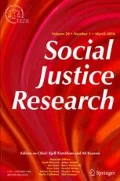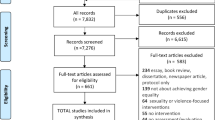Abstract
A program designed for either women, visible minorities, or disabled persons was rated by 264 women and men respondents. An analysis of variance revealed that reactions to affirmative action varied according to the sex of the respondent and the group targeted by the policy. Further analyses were conducted to examine the effects of two social justice concerns on support for affirmative action, that is, scope of justice (extending fair treatment onto others) and perceived threat on behalf of nondesignated groups. According to findings, the link between social justice concerns and reactions to the policy was affected by the group targeted by affirmative action. Furthermore, both social justice concerns were not equally important predictors of attitudes toward affirmative action for women and men respondents.
Similar content being viewed by others
REFERENCES
Beaton, A. M., and Tougas, F. (1997). The representation of women in management: The more, the merrier? Pers. Soc. Psychol. Bull. 23: 773–782.
Beaton, A. M., Tougas, F., and Joly, S. (1996). Neosexism among male managers: Is it a matter of numbers? J. Appl. Soc. Psychol. 26: 2189–2203.
Boeckmann, R. J., and Tyler, T. R. (1997). Commonsense justice and inclusion within the moral community—When do people receive procedural protection from other. Psychol. Publ. Policy Law 3: 362–380.
Clayton, S. (1992). Remedies for discrimination: Race, sex and affirmative action. Behav. Sci. Law 10: 245–257.
Clayton, S. (1996). Reactions to social categorization: Evaluating one argument against affirmative action. J. Appl. Soc. Psychol. 26: 1472–1493.
Collins, L. H., Chrisler, J. C., and Quina, K. (eds.). (1998). Career Strategies for Women in Academe. Sage, Thousand Oaks, CA.
Crosby, F. J., and Lubin, E. P. (1990). Extending the moral community: Logical and psychological dilemmas. J. Soc. Issues 46: 163–172.
Dovidio, J. F., Mann, J. A., and Gaertner, S. L. (1989). Resistance to affirmative action: The implication of aversive racism. In Blanchard, F. A., and Crosby, F. J. (eds.), Affirmative Action in Perspective, Springer-Verlag, New York, pp. 83–102.
Fletcher, J. F., and Chalmers, M.-C. (1991). Attitudes of Canadians toward affirmative action: Opposition, value pluralism, and nonattitudes. Pol. Behav. 13: 67–93.
Fox-Keller, E. (1985). Reflections on Gender and Science. Yale University Press, New Haven, CT.
Franco, F. M., and Maass, A. (1999). Intentional control over prejudice: When the choice of the measure matters. Eur. J. Soc. Psychol. 29: 469–477.
Hagendoorn, L. (1995). Intergroup biases in multiple group systems: The perception of ethnic hierarchies. In Stroebe, W., and Hewstone, M. (eds.), European Review of Social Psychology, John Wiley, New York, Vol. 6, pp. 199–228.
Holloway, F. A. (1989). What is affirmative action? In Blanchard, F. A., and Crosby, F. J. (eds.), Affirmative Action in Perspective, Springer-Verlag, New York, pp. 9–19.
Hitt, M. A., and Keats, B. W. (1984). Empirical identification of thee criteria for effective affirmative action programs. J. Appl. Behav. Sci. 20: 203–222.
Human Resources Development Canada. (1998). Annual Report: Employment Equity Act, Department of Supply and Services Canada, Ottawa.
Jaccard, J., Turrisi, R., and Wan, C. K. (1990). Interaction Effects in Multiple Regression, Sage, Thousand Oaks, CA.
Johnston, W. B., and Packer, A. H. (1987). Workforce 2000: Work and Workers for the Twenty-First Century. Hudson Institute, Indianapolis, IN.
Kravitz, D. A., and Platania, J. (1993). Attitudes and beliefs about affirmative action: Effects of target and of respondent sex and ethnicity. J. Appl. Psychol. 78: 928–938.
Lind, E. A., and Tyler, T. R. (1988). The Social Psychology of Procedural Justice, Plenum Press, New York.
Lovrich, N. P., Steel, B. S., and Hood, D. (1986). Equity versus productivity: Affirmative action and municipal police services. Publ. Prod. Rev. 39: 61–72.
Murrell, A. J., Dietz-Uhler, B. L., Dovidio, J. F., Gaertner, S. L., and Drout, C. (1994). Aversive racism and resistance to affirmative action: Perceptions of justice are not necessarily color blind. Basic Appl. Soc. Psychol. 15: 71–86.
Nacoste, R.W., and Hummels, B. (1994). Affirmative action and the behavior decision makers. J. Appl. Soc. Psychol. 24: 595–613.
Newman, J. D. (1989). Affirmative action and the courts. In Blanchard, F. A., and Crosby, F. J. (eds.), Affirmative Action in Perspective, Springer-Verlag, New York, pp. 31–49.
Nordstrom, C. R., Huffaker, B. J., and Williams, K. B. (1998). When physical disabilities are not liabilities: The role of applicant and interviewer characteristics on employment interview outcomes. J. Appl. Soc. Psychol. 28: 283–306.
Offermann, L. R., and Gowing, M. K. (1990). Organizations of the future: Changes and challenges. Am. Psychol. 45: 95–108.
Opotow, S. (1990). Moral exclusion and injustice: An introduction. J. Soc. Issues 46: 1–20.
Opotow, S. (1993). Animals and the scope of justice. J. Soc. Issues 49: 71–85.
Opotow, S. (1995). Drawing the line: Social categorization, moral exclusion, and the scope of justice. In Bunker, B. B., and Rubin. J. Z. (eds.), Conflict, Cooperation and Justice, Jossey-Bass, San Fransisco, CA, pp. 347–369.
Opotow, S. (1996). Affirmative action, fairness, and the scope of justice. J. Soc. Issues 52: 19–24.
Pratkanis, A. R., and Turner, M.E. (1996). The proactive removal of discriminatory barriers: Affirmative action as effective help. J. Soc. Issues 52: 111–132.
Pratkanis, A. R., and Turner, M. E. (1999). The significance of affirmative action for the souls of White folk: Further implications of a helping model. J. Soc. Issues 55: 787–815.
Pratto, F., Sidanius, J., and Stallworth, L. M. (1993). Sexual selection and the sexual and ethnic basis of social hierarchy. In Ellis, L. (ed.), Social Stratification and Socioeconomic Iinequality: A Comparative Biosocial Analysis, Praeger, Westport, CT, pp. 111–137.
Raskin, C. (1994). Employment equity for the disabled in Canada. Int. Labour Rev. 133: 75–88.
Robinson, J. G., and McIlwee, J. S. (1991). Men, women and the culture of Engineering. Soc. Q. 32: 403–421.
Sidanius, J., and Pratto, F. (1993). The inevitability of oppression and the dynamics of social dominance. In Sniderman, P. M., Tetlock, Ph. E., and Carmines, E. G. (eds.), Prejudice, Politics, and the American Dilemma, Stanford University Press, Stanford, CA, pp. 173–211.
Sidanius, J., Pratto, F., and Brief, D. (1995). Group dominance and the political psychology of gender: A cross-cultural comparison. Pol. Psychol. 16: 381–396.
Sidanius, J., Pratto, F., and Rabinowitz, J. L. (1994). Gender, ethnic status, and ideological asymmetry: A social dominance interpretation. J. Cross-Cultural Psychol. 25: 194–216.
Singer, M. S. (1996). Effects of scope of justice, informant ethnicity and information frame on attitudes towards ethnicity-based selection. Int. J. Psychol. 31: 191–205.
Smith, E. R., and Kluegel, J. R. (1984). Beliefs and attitudes about women's opportunity: Comparisons with beliefs about Blacks and a general perspective. Soc. Psychol. Q. 47:81–95.
Smith, H. J., and Tyler, T. R. (1996). Justice and power: When will justice concerns encourage the advantaged to support policies which redistribute economic resources and the disadvantaged to willingly obey the law? Eur. J. Soc. Psychol. 26:171–200.
Steel, B. S., and Lovrich, N. P. (1987). Equality and efficiency tradeoffs on affirmative action-Real or imagined? The case of women in policing. Soc. Sci. J. 24: 53–70.
Tabachnick, B. G., and Fidell, L. S. (1996). Using Multivariate Statistics, 3rd edn., Harper Collins, New York.
Taylor, D. A. (1989). Affirmative action and presidential executive orders. In Blanchard, F. A., and Crosby, F. J. (eds.), Affirmative Action in Perspective, Springer-Verlag, New York, pp. 21–29.
Tomasson, R. F., Crosby, F. J., and Herzberger, S. D. (1996). Affirmative Action: The Pros and Cons of Policy and Practice, The American University Press, Washington, DC.
Tougas, F., and Beaton, A. M. (1993). Affirmative action in the work place: For better or for worse. Appl. Psychol. Int. Rev. 42: 253–264.
Tougas, F., Brown, R., Beaton, A. M., and Joly, S. (1995). Neosexism: Plus Ça change, plus c'st pareil. Pers. Soc. Psychol. Bull. 21: 842–849.
Tougas, F., Brown, R., Beaton, A. M., and St-Pierre, L. (1999). Neosexism among women: The role of personally experienced social mobility attempts. Pers. Soc. Psychol. Bull. 25: 1487–1497.
Tougas, F., Joly, S., Beaton, A. M., and St-Pierre, L. (1998). Préjugés racistes et évaluations négatives des programmes d'acc#x00E8;s à l'égalité et de leurs bénéficiaires. Can. J. Adm. Sci. 15: 245–254.
Tougas, F., and Veilleux, F. (1992). Quelques déterminants des réactions des hommes et des femmes à l'action positive. Rev. québécoise psychol. 13: 1–13.
Tyler, T. R., Boeckmann, R. J., Smith, H. J., and Huo, Y. J. (1997). Social Justice in a Diverse Society, Westview Press, Boulder, CO.
Author information
Authors and Affiliations
Rights and permissions
About this article
Cite this article
Beaton, A.M., Tougas, F. Reactions to Affirmative Action: Group Membership and Social Justice. Social Justice Research 14, 61–78 (2001). https://doi.org/10.1023/A:1012575724550
Issue Date:
DOI: https://doi.org/10.1023/A:1012575724550



